Electrosynthesis of Titanium Alloys from Spent SCR Catalysts
Abstract
1. Introduction
2. Experimental
2.1. Raw Materials and Characterization
2.2. Experimental Methods
3. Results and Discussion
3.1. Characterization of the Spent SCR Catalyst
3.2. Effects of High-Temperature Pretreatment
3.3. Electrolytic Products
3.4. Electroreduction Process
4. Conclusions
Author Contributions
Funding
Data Availability Statement
Conflicts of Interest
References
- Li, J.; Chang, H.; Ma, L.; Hao, J.; Yang, R.T. Low-temperature selective catalytic reduction of NOx with NH3 over metal oxide and zeolite catalysts—A review. Catal. Today 2011, 175, 147–156. [Google Scholar] [CrossRef]
- Shi, Q.; Du, X.; Wang, X.; Yang, G.; Wan, Y.; Chen, Y.; Song, L.; Xue, Z.; Zhang, L. Recycling of Waste SCR Catalysts Using a Catalytic Filter: A Study on the Catalytic Performance for NOx Abatement. Ind. Eng. Chem. Res. 2021, 60, 4622–4629. [Google Scholar] [CrossRef]
- Liu, J.; Wang, C.; Wang, X.; Zhao, C.; Li, H.; Zhu, G.; Zhang, J. Reconstruction and recovery of anatase TiO2 from spent selective catalytic reduction catalyst by NaOH hydrothermal method. Chin. J. Chem. Eng. 2023, 60, 53–60. [Google Scholar] [CrossRef]
- Cao, Y.; Han, F.; Wang, M.; Han, L.; Zhang, C.; Wang, J.; Bao, W.; Chang, L. Regeneration of the waste selective catalytic reduction denitrification catalyst by nitric acid washing. ACS Omega 2019, 4, 16629–16637. [Google Scholar] [CrossRef]
- Yang, B.; Zhou, J.; Wang, W.; Liu, C.; Zhou, D.; Yang, L. Extraction and separation of tungsten and vanadium from spent V2O5–WO3/TiO2 SCR catalysts and recovery of TiO2 and sodium titanate nanorods as adsorbent for heavy metal ions. Colloids Surf. A 2020, 601, 124963. [Google Scholar] [CrossRef]
- Feng, E.; Gao, D.; Yu, F.; Chen, J.; Xu, Z.; Zhang, W.; Wang, C.; Gao, Y.; Wen, J.; Huang, G.; et al. TiO2 recovered from spent selective catalytic reduction catalysts as anode material for lithium-ion batteries. J. Clean. Prod. 2024, 444, 141120. [Google Scholar] [CrossRef]
- Zhao, C.; Wang, C.; Wang, X.; Li, H.; Chen, Y.; Wu, W. Recovery of tungsten and titanium from spent SCR catalyst by sulfuric acid leaching process. Waste Manag. 2023, 155, 338–347. [Google Scholar] [CrossRef]
- Liu, J.; Wang, C.; Hou, X.; Li, H.; Wang, X.; Hu, W.; Ge, T.; Zhang, J.; Zhu, G.; Xie, H. Extraction of W, V, and As from spent SCR catalyst by alkali pressure leaching and the pressure leaching mechanism. J. Environ. Manag. 2023, 347, 119107. [Google Scholar] [CrossRef]
- Wang, B.; Yang, Q. Recovery of V2O5 from spent SCR catalyst by H2SO4-ascorbic acid leaching and chemical precipitation. J. Environ. Chem. Eng. 2022, 10, 108719. [Google Scholar] [CrossRef]
- Qian, X.; Ao, W.; Ding, H.; Wang, X.; Sun, S. A Review on Resource Utilization of Spent V-W-Ti Based Selective Catalytic Reduction Catalysts. Materials 2022, 15, 7984. [Google Scholar] [CrossRef]
- Zhao, J.; Zhang, X.; Yang, F.; Ai, Y.; Chen, Y.; Pan, D. Strategy and Technical Progress of Recycling of Spent Vanadium-Titanium-Based Selective Catalytic Reduction Catalysts. ACS Omega 2024, 9, 6036–6058. [Google Scholar] [CrossRef]
- Zhang, X.; Zhang, S.; Deng, L.; Wang, J.; Wu, B.; Liu, B.; Zhang, B. Selective leaching of V, W and recycling of TiO2 carrier from waste V2O5-WO3/TiO2 catalysts by mixed alkali liquor. Sustain. Chem. Pharm. 2023, 36, 101234. [Google Scholar] [CrossRef]
- Ding, L.; Wang, Y.; Qian, L.; Qi, P.; Xie, M.; Long, H. Flue gas deNOxing spent V2O5-WO3/TiO2 catalyst: A review of deactivation mechanisms and current disposal status. Fuel 2023, 338, 127268. [Google Scholar] [CrossRef]
- Choi, I.-H.; Kim, H.-R.; Moon, G.; Jyothi, R.K.; Lee, J.-Y. Spent V2O5-WO3/TiO2 catalyst processing for valuable metals by soda roasting-water leaching. Hydrometallurgy 2018, 175, 292–299. [Google Scholar] [CrossRef]
- Yao, J.; Cao, Y.; Wang, J.; Zhang, C.; Wang, W.; Bao, W.; Chang, L. Successive calcination-oxalate acid leaching treatment of spent SCR catalyst: A highly efficient and selective method for recycling tungsten element. Hydrometallurgy 2021, 201, 105576. [Google Scholar] [CrossRef]
- Xiao, H.; Chen, L.; Qin, Z.; Yin, R.; Weng, D.; Wang, Z.; Luo, D. Separation of vanadium, tungsten and molybdenum from spent SCR catalysts solution by solvent extraction with primary amine N1923. Waste Manag. 2022, 150, 301–309. [Google Scholar] [CrossRef] [PubMed]
- Wang, M.; Zhang, Y.; Li, Z.; Li, J.; Ma, W.; Lei, Y. Preparation of low-oxygen Ti–Al alloy by sustainable recovery of spent SCR catalyst. Sep. Purif. Technol. 2024, 343, 127060. [Google Scholar] [CrossRef]
- Li, Z.; Yang, L.; Ma, W.; Lei, Y. Eutectic Si–Ti brazing alloy prepared from spent selective catalytic reduction catalyst and diamond-wire sawing silicon waste. Chem. Eng. J. 2024, 496, 154053. [Google Scholar] [CrossRef]
- Kang, J.; Tian, Z.; Zhong, D.; Yang, L.; Mao, H.; Qiu, G.; Lv, X. Deoxidation thermodynamics of Ti–O in hydrogen atmosphere: Preparation of TiH2 alloy powder by direct reduction of spent V2O5–WO3/TiO2 catalyst with magnesiothermic. J. Mater. Res. Technol. 2023, 22, 1088–1102. [Google Scholar] [CrossRef]
- Cao, J.; Gu, H.Z.; Wu, J.J.; Wei, K.X.; Zeng, Y.; Ma, W.H. Recycling of Ti and Si from Ti-bearing blast furnace slag and diamond wire saw silicon waste by flux alloying technique. J. Environ. Manag. 2024, 362, 121302. [Google Scholar] [CrossRef] [PubMed]
- Lu, X.; Zhang, Z.; Hiraki, T.; Takeda, O.; Zhu, H.; Matsubae, K.; Nagasaka, T. A solid-state electrolysis process for upcycling aluminium scrap. Nature 2022, 606, 511–515. [Google Scholar] [CrossRef]
- Martin-Treceno, S.; Weaver, N.; Allanore, A.; Bishop, C.M.; Marshall, A.T.; Watson, M.J. Electrochemical behaviour of titanium-bearing slag relevant for molten oxide electrolysis. Electrochim. Acta 2020, 354, 136619. [Google Scholar] [CrossRef]
- Zhou, Z.; Zhang, Y.; Dong, P.; Hua, Y.; Zhang, Q.; Wang, D.; Duan, J.; Zhang, Z. Electrolytic synthesis of TiC/SiC nanocomposites from high titanium slag in molten salt. Ceram. Int. 2018, 44, 3596–3605. [Google Scholar] [CrossRef]
- Li, S.; Zou, X.; Zheng, K.; Lu, X.; Chen, C.; Li, X.; Xu, Q.; Zhou, Z. Electrosynthesis of Ti5Si3, Ti5Si3/TiC, and Ti5Si3/Ti3SiC2 from Ti-Bearing Blast Furnace Slag in Molten CaCl2. Metall. Mater. Trans. B 2018, 49, 790–802. [Google Scholar] [CrossRef]
- Lang, X.C.; Xie, H.W.; Zou, X.Y.; Kim, P.H.; Zhai, Y.C. Investigation on Direct Electrolytic Reduction of the CaTiO3 Compounds in Molten CaCl2-NaCl for the Production of Ti. Adv. Mater. Res. 2011, 284–286, 2082–2085. [Google Scholar] [CrossRef]
- Bhagat, R.; Jackson, M.; Inman, D.; Dashwood, R. Production of Ti–W Alloys from Mixed Oxide Precursors via the FFC Cambridge Process. J. Electrochem. Soc. 2009, 156, E1. [Google Scholar] [CrossRef]
- Hu, M.; Ma, T.; Gao, L.; Lai, P.; Qu, Z.; Wen, L.; Li, D.; Zhang, S.; Hu, M. Phase Transformations and Deoxidation Kinetics during the Electrochemical Reduction of TiO2 in Molten CaCl2. Mater. Trans. 2019, 60, 416–421. [Google Scholar] [CrossRef]

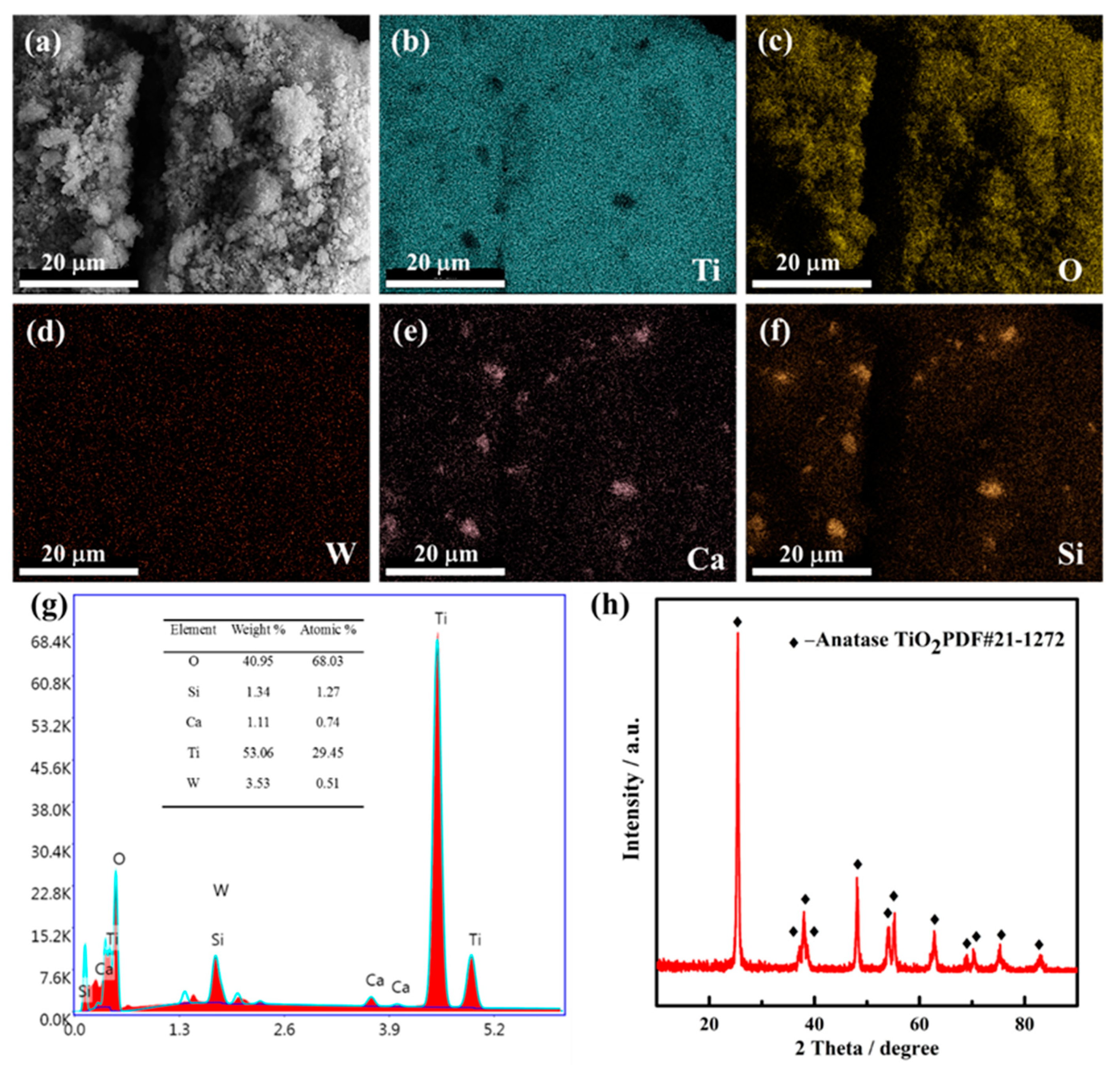


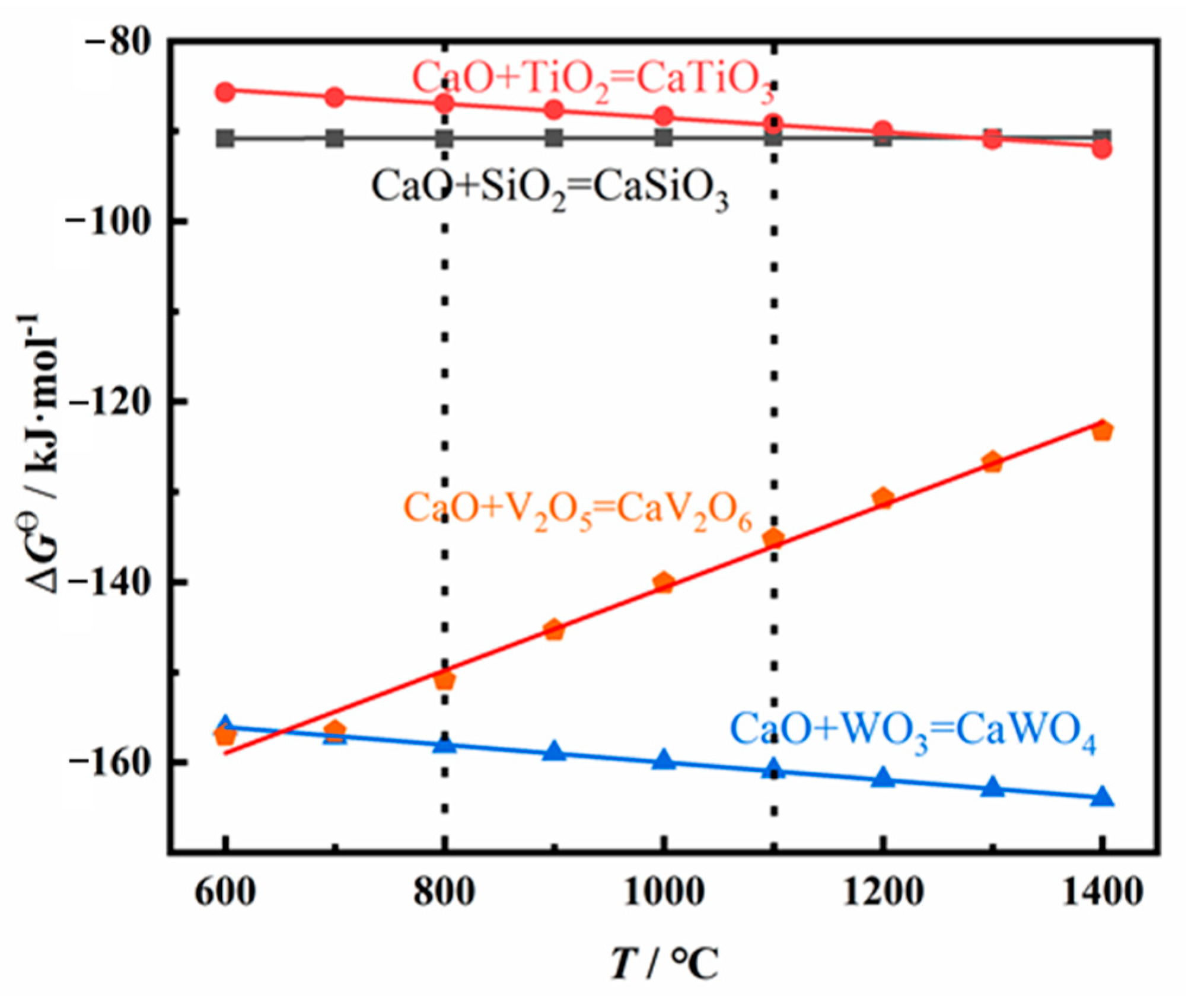
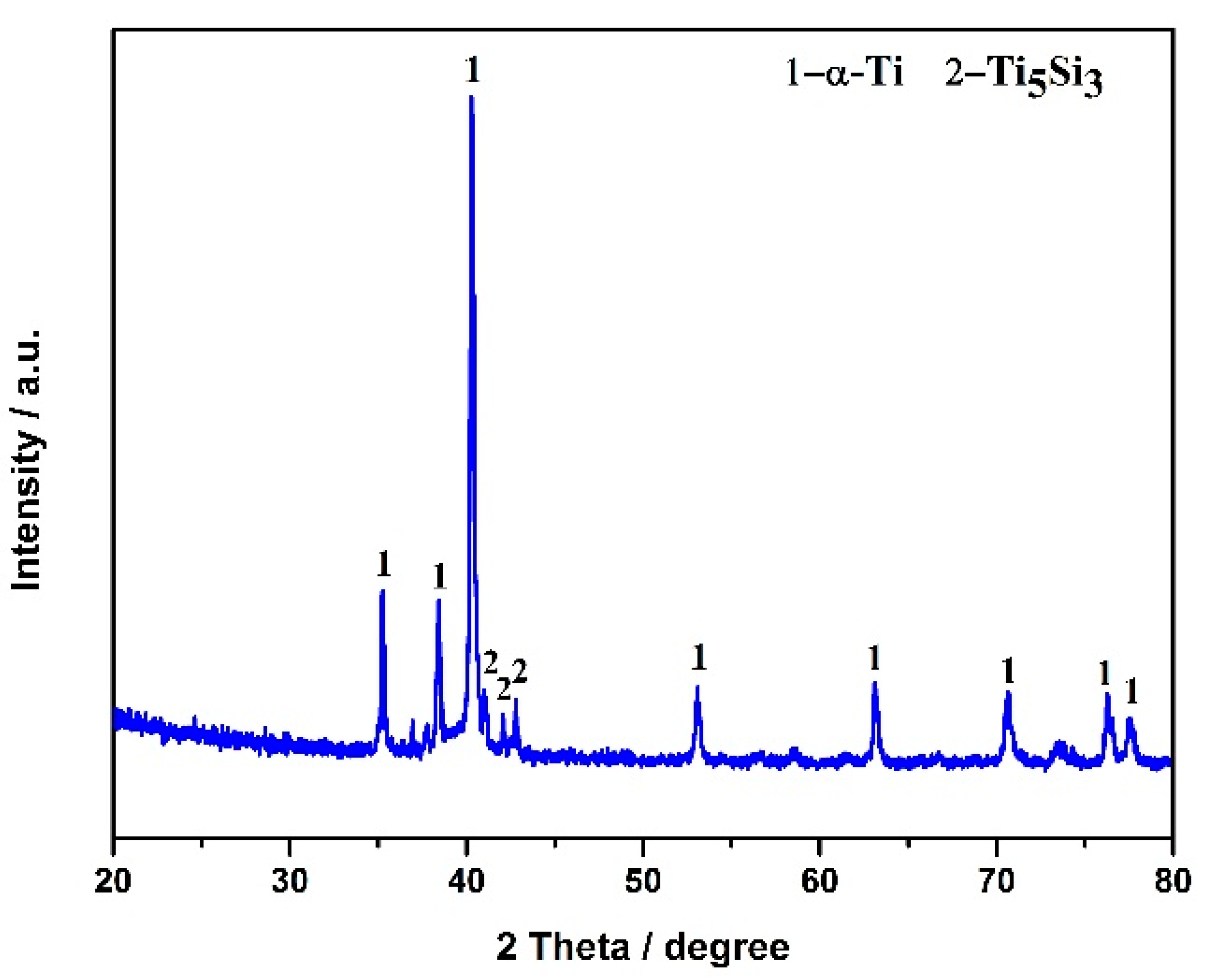
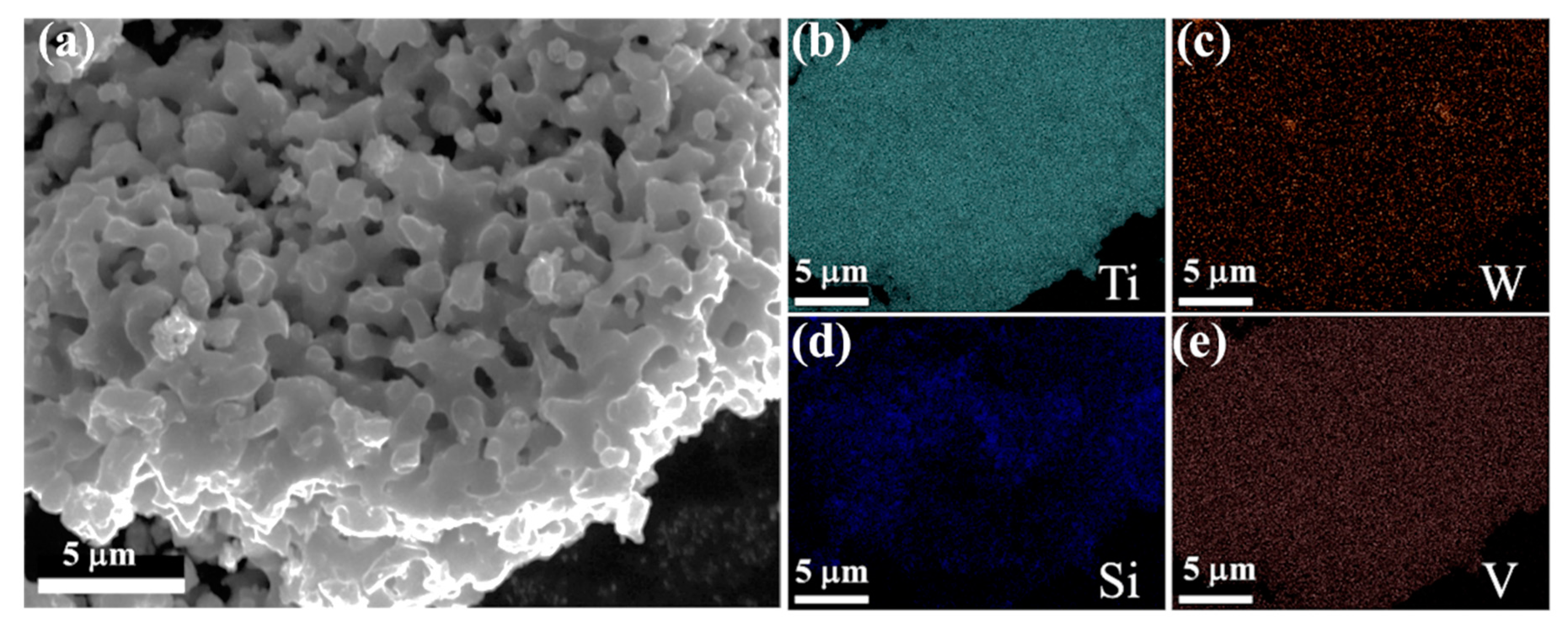

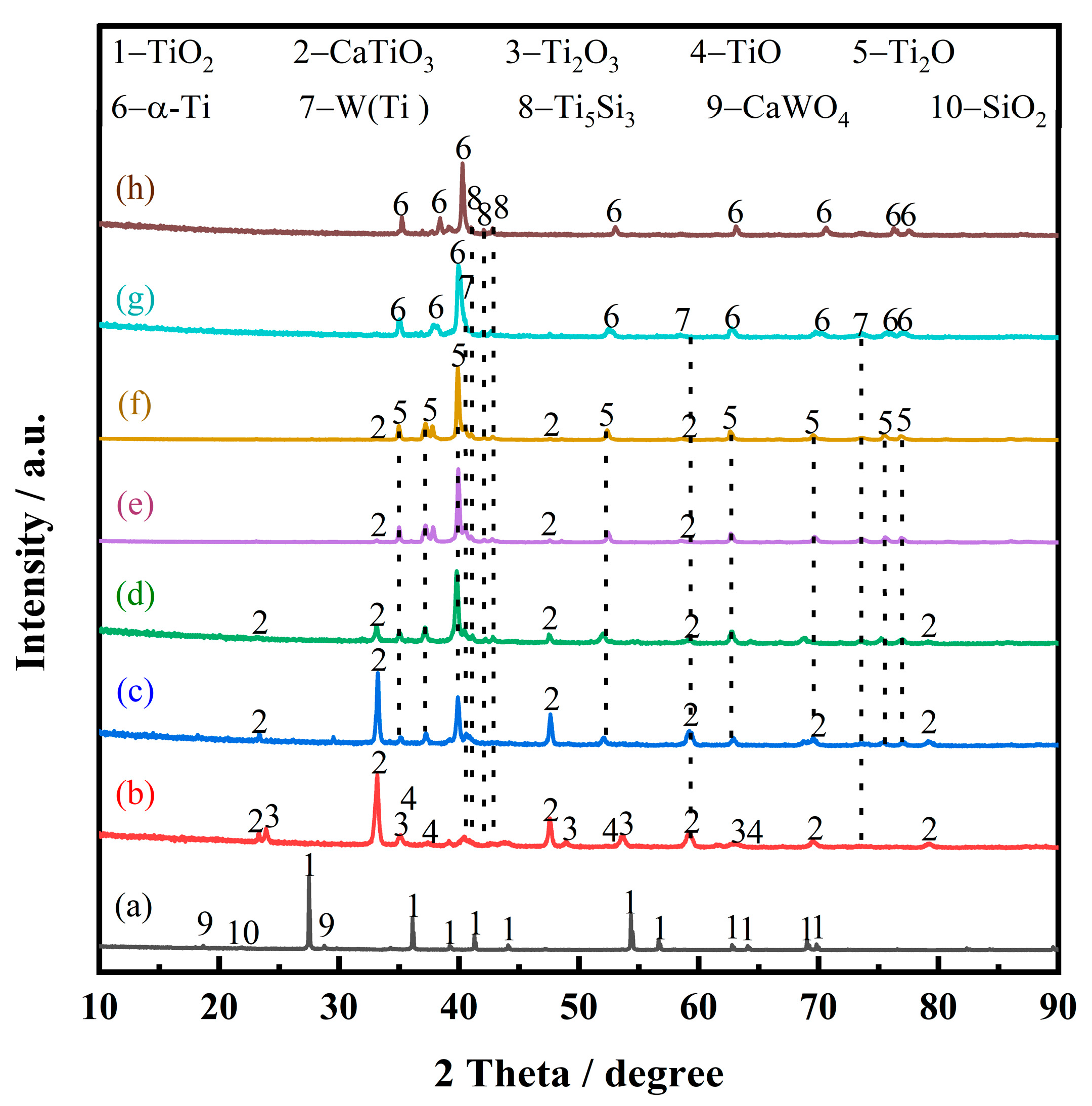
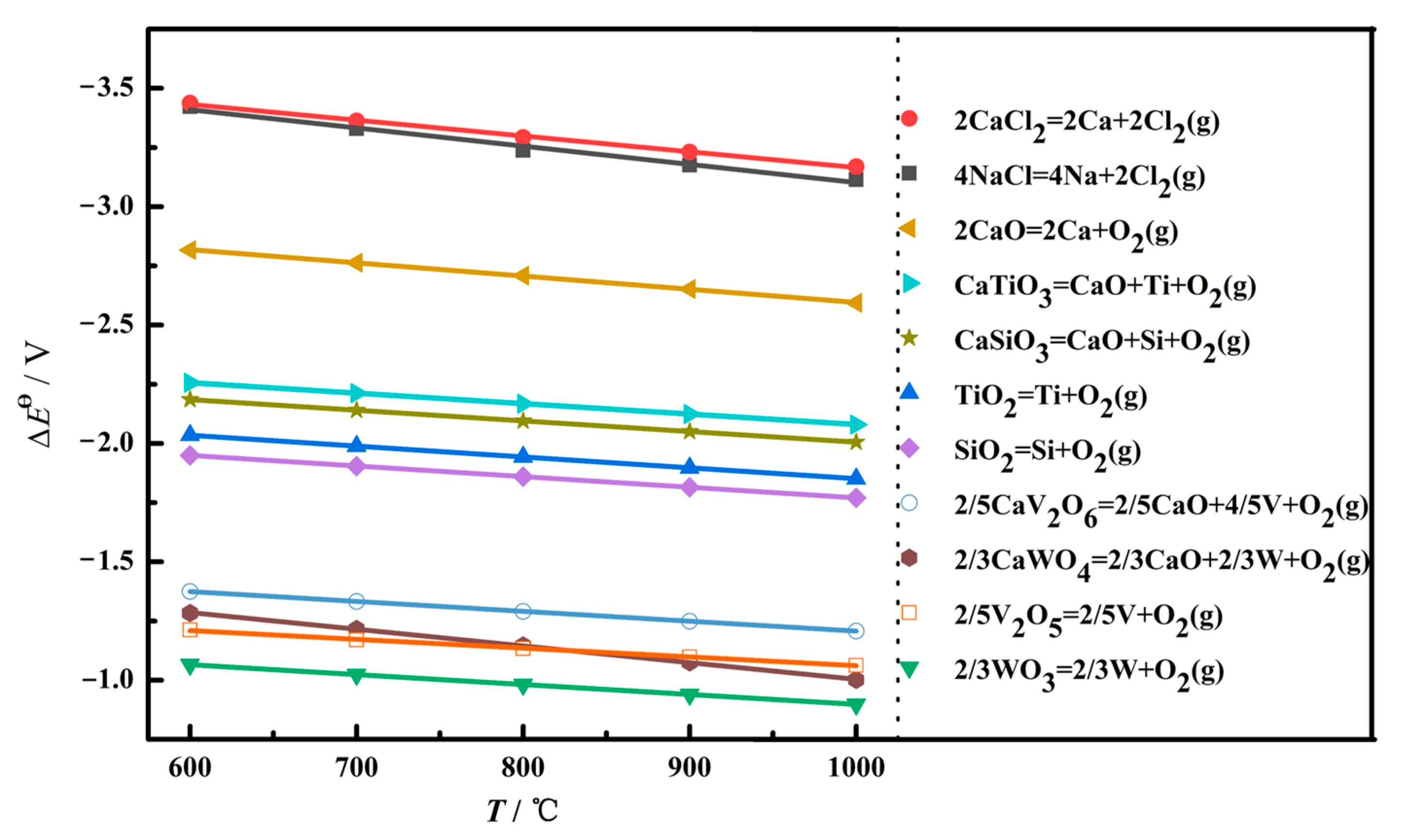

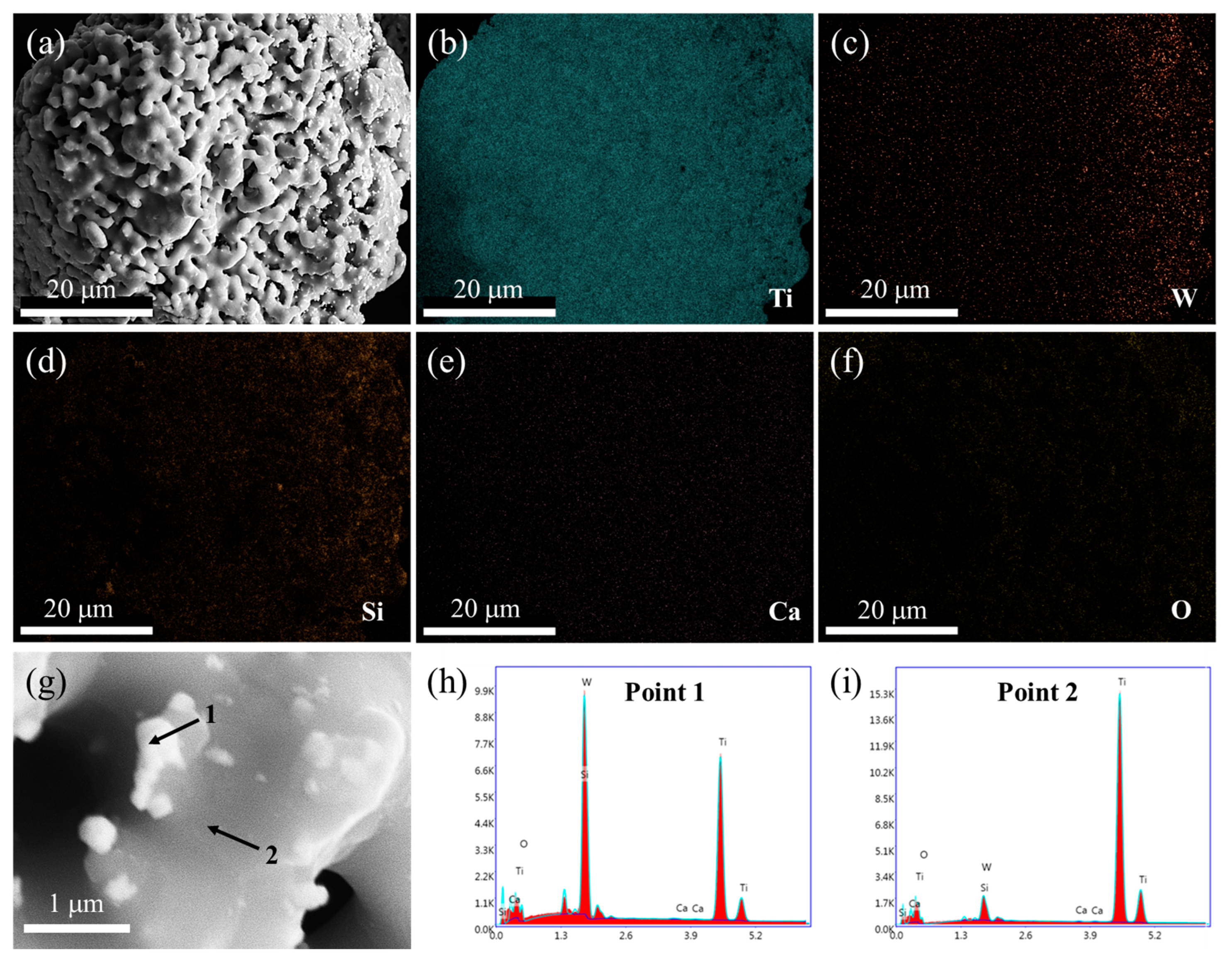

| Component | TiO2 | WO3 | SiO2 | CaO | V2O5 | SO3 | F | Others |
| Mass fraction | 85.4 | 5.1 | 4.4 | 1.4 | 0.9 | 0.6 | 0.6 | 1.6 |
| Component | TiO2 | WO3 | SiO2 | CaO | V2O5 | SO3 | F | others |
| Mass fraction | 88.2 | 5.3 | 3.5 | 1.0 | 0.9 | 0.0 | 0.0 | 1.1 |
Disclaimer/Publisher’s Note: The statements, opinions and data contained in all publications are solely those of the individual author(s) and contributor(s) and not of MDPI and/or the editor(s). MDPI and/or the editor(s) disclaim responsibility for any injury to people or property resulting from any ideas, methods, instructions or products referred to in the content. |
© 2025 by the authors. Licensee MDPI, Basel, Switzerland. This article is an open access article distributed under the terms and conditions of the Creative Commons Attribution (CC BY) license (https://creativecommons.org/licenses/by/4.0/).
Share and Cite
Zheng, L.; Jin, J.; Cai, Z.; Li, X.; Zhu, Q.; Cao, W. Electrosynthesis of Titanium Alloys from Spent SCR Catalysts. Crystals 2025, 15, 83. https://doi.org/10.3390/cryst15010083
Zheng L, Jin J, Cai Z, Li X, Zhu Q, Cao W. Electrosynthesis of Titanium Alloys from Spent SCR Catalysts. Crystals. 2025; 15(1):83. https://doi.org/10.3390/cryst15010083
Chicago/Turabian StyleZheng, Long, Jiahao Jin, Zongying Cai, Xiangpeng Li, Qi Zhu, and Weigang Cao. 2025. "Electrosynthesis of Titanium Alloys from Spent SCR Catalysts" Crystals 15, no. 1: 83. https://doi.org/10.3390/cryst15010083
APA StyleZheng, L., Jin, J., Cai, Z., Li, X., Zhu, Q., & Cao, W. (2025). Electrosynthesis of Titanium Alloys from Spent SCR Catalysts. Crystals, 15(1), 83. https://doi.org/10.3390/cryst15010083






